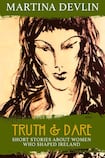
"These women," novelist Martina Devlin writes in her introduction to Truth & Dare, "are my heroes". Often reduced to two-dimensional characters, or written out of history, their actions nevertheless still "reverberate" over time. In this, her first collection of short stories, Devlin attempts a re-animation, bringing back a cast of historical women in all their radicalism and contentious vivacity.
Devlin takes a broad and ambitious sweep, showing a skilled application and understanding of Irish history and the sociopolitical contexts of the women’s lives. She also explores both unionist and nationalist women; those who put suffrage at the forefront of their politics, and those who lobbied for industrial change. We begin with Mary Ann McCracken, a social reformer and abolitionist who is depicted buying caged birds from the market so that she can set them free, an apt prefiguring of her later activism. Though her story focuses mainly on her relationship with her brother, and ends before her radicalism really begins, it sets the tone for the collection as one which skilfully animates historical contexts for unfamiliar readers.
Other women in Devlin’s cast include Hannah Sheehy-Skeffington, who is imprisoned in 1918 in Holloway Prison, dreading being force-fed, and Nano Nagle, who was named Irish Woman of the Millennium in 2000.
These are not all unknown or unfamiliar historical figures. Maud Gonne, for example, and Countess Markievicz, are included. What is illuminating when the collection is read from start to finish, however, is the intellectual and political interactions between the women, echoing over time. Anna Parnell’s studied avoidance of sugar (due to its colonial entanglements) finds a long tail in Mary Ann McCracken’s sugar-abstinence in protest of the slave trade. Likewise, Devlin emphasises these women as important forerunners and touchstones for later progressives. The women of the suffrage movement, for example, found inspiration in the organisational skills of the activists of the Ladies’ Land League.
‘Sticks of dynamite’
Some of the women are writers themselves (Speranza, Somerville and Ross, Alice Milligan), and Devlin's work capitalises on the acts of recovery being undertaken across Irish publishing by various editors, including the publishers of Dorothy Macardle's work (Tramp Press published her ghost story The Uninvited in 2015) and Sinéad Gleeson's anthology of stories The Glass Shore, in which Devlin's Somerville and Ross story was originally published. Truth & Dare is a worthy contribution to this exciting shift in contemporary Irish writing.
Formally, these stories are not particularly innovative, and often include a wide time frame. Mary Ann McCracken’s story, for example, moves from 1778 to 1798, and Lady Jane Wilde (or Speranza)’s story also goes back to 1871 and returns to the time when Oscar was in Reading Gaol. In some, the stories we get are somewhat pedestrian, considering that “these women were sticks of dynamite”. That said, their protest is sometimes couched in a non-conformity which, though not explosive, is radical in its context. Devlin provides a short biographical introduction to each figure and a short afterword to each story regarding their subject’s legacy, their afterlife.
Imagined narratives
Sometimes the tone toes a precarious line between biography and fiction, perhaps caught uncomfortably between a desire to give historical fact and to inhabit an imagined world. This didactic impulse can also make the process of reading feel forced at time, but that is not to say that there isn’t much of value and insight in these pages, which revivify a cast of figures in ways that effectively implant them in the memory.
The short story form, in giving glimpses, flashes of character and impulse, leaves us curious. No doubt Devlin’s book will lead readers to further seek out historical and biographical works on these women, and that might be where its key strength lies. As Devlin writes in her introduction to the collection, on her decision to write these stories as imagined narratives rather than biographical entries, fiction has an “uncanny hold” on the reader, an “enchantment” that allows us to live, however briefly, in the life of another.











